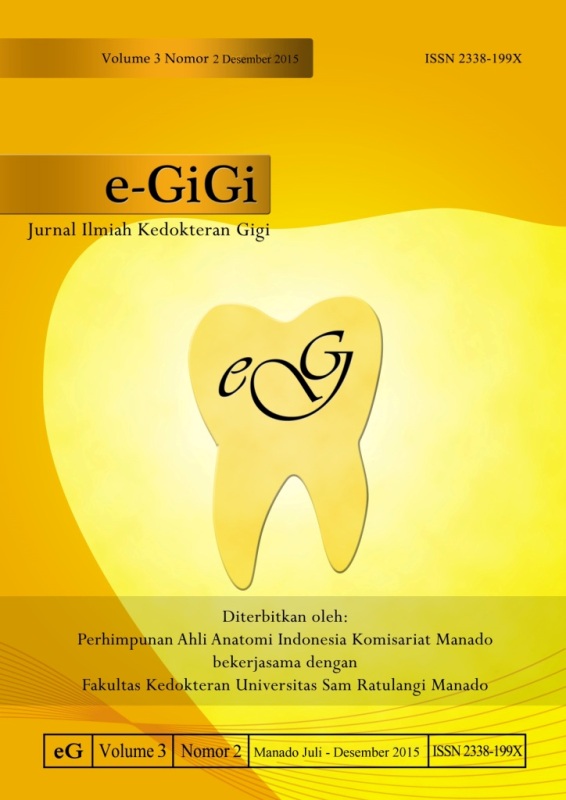GAMBARAN PENYAKIT PERIODONTAL PADA PENDERITA DIABETES MELITUS DI RUMAH SAKIT UMUM PUSAT PROF. DR. R. D KANDOU MANADO
DOI:
https://doi.org/10.35790/eg.3.2.2015.10399Abstract
Abstract: Diabetes mellitus (DM) is a group of metabolic diseases with characteristic hyperglycemia that occurs due to insulin secretion, insulin action or both. This disease affects many societies and continuously growing in Indonesia. Periodontal disease is an oral health problem which has a relatively high prevalence in the community where periodontal disease in all age groups in Indonesia.The purpose of this study was to determine the periodontal disease in patients with diabetesmellitus in RSUP Prof. dr. R. D. Kandou Manado. This descriptive study has 68 sample taken with total sampling technique. The sample is examined using evaluation criteria gingival index and CPITN index. The result show that subjects with periodontitis with a score of 4 is the highest as many as 18 people (44%) and subject with a score of 2 is that at least as many as 8 people (19.5%). And subjects with bad gingivitis is the highest as many as 10 people (52.6%) and subject with the good gingivitis is the at least as many as 5 people (26.3%). Based on the result of this study, periodontal disease in patients with diabetes mellitus in RSUP Prof. Dr. R. D. Kandou most that periodontitis with the number of 41 people (68.3%) compared to gingivitis which is just as many as 19 people (31.7%)
Keywords: diabetes mellitus, periodontitis, gingivitis, periodontal
Abstrak:Diabetes Melitus (DM) merupakan suatu kelompok penyakit metabolik dengan karakteristik hiperglikemia yang terjadi karena sekresi insulin, kerja insulin atau kedua-duanya. Penyakit ini merupakan penyakit yang banyak diderita kalangan masyarakat dan terus berkembang di Indonesia. Penyakit periodontal merupakan masalah kesehatan gigi dan mulut yang memiliki prevalensi cukup tinggi di masyarakat dimana penyakit periodontal pada semua kelompok umur di Indonesia.Tujuan penelitian ini adalah untuk mengetahui penyakit periodontal pada penderita diabetes mellitus di RSUP Prof. dr. R. D. Kandou Manado. Jenis penelitian ini adalah penelitian deskriptif dengan jumlah sampel 60 orang yang diambil dengan teknik total sampling. Sampel diperiksa dengan menggunakan kriteria penilaian indeks gingiva dan indeks CPITN. Hasil menunjukkan bahwa yang mengalami periodontitis dengan skor 4 adalah yang paling tinggi yaitu sebanyak 18 orang (44%), dan subjek yang mengalami skor 2 adalah yang yang paling sedikit yaitu sebanyak 8 orang (19.5%). Sedangkan yang mengalami gingivitis yang paling tinggi yaitu gingivitis buruk sebanyak 10 orang (52.6%) dan yang paling sedikit adalah yang mengalami gingivitis ringan yaitu sebanyak 5 orang (26.3%). Berdasarkan hasil penelitian ini dapat disimpulkan bahwa penyakit periodontal yang paling banyak ditemui pada penderita diabetes melitus di RSUP Prof. Dr. R. D. Kandou Manado adalah penyakit periodontitis yaitu sebanyak 41 orang (68.3%) dan yang paling sedikit adalah gingivitis yaitu sebanyak 19 orang (31.7%)
Kata kunci: diabetes melitus, periodontitis, gingivitis, periodontal
Downloads
How to Cite
Issue
Section
License
COPYRIGHT
Authors who publish with this journal agree to the following terms:
Authors hold their copyright and grant this journal the privilege of first publication, with the work simultaneously licensed under a Creative Commons Attribution License that permits others to impart the work with an acknowledgment of the work's origin and initial publication by this journal.
Authors can enter into separate or additional contractual arrangements for the non-exclusive distribution of the journal's published version of the work (for example, post it to an institutional repository or publish it in a book), with an acknowledgment of its underlying publication in this journal.
Authors are permitted and encouraged to post their work online (for example, in institutional repositories or on their website) as it can lead to productive exchanges, as well as earlier and greater citation of the published work (See The Effect of Open Access).






